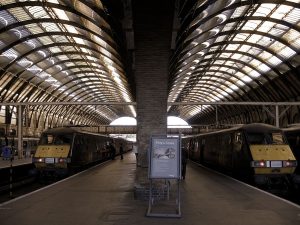The rhythmic clatter of wheels on rails, the whoosh of air as a train speeds past, and the mesmerizing landscapes that blur by—these are the sensations that travellers on the East Coast Main Line (ECML) experience. One of the United Kingdom’s most iconic and historically significant rail routes, the ECML is a vital artery that connects London to the Scottish capital of Edinburgh, spanning approximately 393 miles (632 kilometres) and weaving its way through history, economy, and culture.
History of the East Coast Main Line:
The roots of the East Coast Main Line stretch back to the 19th century, a time of unparalleled industrial growth and transportation revolution. The initial segments of the line were opened in the 1850s, with the entire route reaching completion by the early 20th century. Throughout its existence, the line has played a crucial role in shaping the development of the towns and cities it serves. The graceful curves and imposing viaducts that adorn the route are not merely engineering marvels, but also markers of a bygone era’s determination to conquer geographic obstacles.
Engineering Marvels:
One of the most striking features of the ECML is its impressive engineering infrastructure. As the line traverses varying terrains, it encounters a series of challenges that necessitated ingenious solutions. The Royal Border Bridge in Berwick-upon-Tweed, for example, stands as a testament to Victorian engineering prowess. Designed by Robert Stephenson, this majestic structure spans the River Tweed and showcases the era’s architectural grandeur.
Similarly, the King’s Cross Station in London serves as both a hub of activity and a masterpiece of railway architecture. Its iconic façade and the renowned Platform 9¾, inspired by the famous Harry Potter series, have turned the station into a cultural touchstone. The ECML’s stations, bridges, and tunnels collectively embody a living history that resonates with travellers and enthusiasts alike.
Economic Lifeline:
Beyond its historical significance, the East Coast Main Line functions as a crucial economic artery. The towns and cities linked by this rail route are not only beneficiaries of its connectivity but also contributors to the broader economy. The line facilitates the movement of people and goods, playing a pivotal role in supporting industries and trade along its path.
The ECML corridor hosts a diverse range of industries, from finance and technology hubs in London to manufacturing and energy sectors in cities like Newcastle and Edinburgh. This connectivity attracts businesses seeking efficient transportation links to the UK’s commercial heart and its northern reaches. Additionally, the line supports tourism by connecting travellers to iconic destinations like York, with its medieval architecture, and Durham, famed for its cathedral and university.
Cultural Tapestry:
The East Coast Main Line’s influence transcends infrastructure and economics; it has woven itself into the cultural fabric of the United Kingdom. The train journey itself offers travelers a glimpse into the changing landscapes of England and Scotland. From the urban sprawl of London to the rolling hills of Northumberland, and from the industrial hubs of Yorkshire to the rugged beauty of the Scottish Lowlands, the line showcases the diverse geography of the region.
Furthermore, the rail line has found its way into literature, music, and art. Poets and novelists have often romanticized train travel, and the ECML, with its historic stations and scenic panoramas, provides ample inspiration. Musicians have celebrated the line in songs that capture the essence of a journey filled with anticipation and reflection. The ECML’s influence on culture is a testament to its role as not just a mode of transport, but a source of inspiration and artistic expression.
Challenges and Future:
Despite its storied history and manifold contributions, the East Coast Main Line has not been without challenges. The rail industry faces the perennial pressure of modernization, striving to strike a balance between preserving the line’s heritage and updating it to meet contemporary needs. Investment in infrastructure, technology, and sustainability will be vital to ensure the line’s continued relevance.
Looking forward, the ECML holds the potential to be a centerpiece of a sustainable transportation future. As the world grapples with climate change, the rail network’s lower carbon footprint compared to other modes of transportation positions it as an eco-friendly option. Investments in electrification, high-speed rail, and improved connectivity could enhance its efficiency and attractiveness, making it an even more essential part of the country’s transport landscape.
The East Coast Main Line is not just a means of travel; it’s a narrative of history, a lifeline for the economy, and a canvas for culture. Its tracks carry the echoes of steam engines from yesteryears, the aspirations of a thriving business landscape, and the whispers of poets and artists who’ve been captivated by its charm. As the UK continues to evolve, the ECML stands as a symbol of connectivity, resilience, and progress—an enduring thread that binds the past with the present and propels the nation into the future.
If you want to read about another major rail within the UK click here. For our YouTube Page click here.

